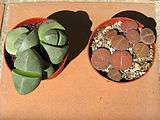Pleiospilos bolusii
| Pleiospilos bolusii | |
|---|---|
| | |
| Pleiospilos bolusii at the Orto Botanico dell'Università di Genova | |
| Scientific classification | |
| Kingdom: | Plantae |
| (unranked): | Angiosperms |
| (unranked): | Eudicots |
| (unranked): | Core eudicots |
| Order: | Caryophyllales |
| Family: | Aizoaceae |
| Genus: | Pleiospilos |
| Species: | P. bolusii |
| Binomial name | |
| Pleiospilos bolusii (Hook.f.) N.E.Br. | |
| Synonyms | |
Pleiospilos bolusii (mimicry plant) is a species of flowering plant in the family Aizoaceae, native to the Eastern Cape of South Africa, where it grows at an altitude of 750–1,100 m (2,461–3,609 ft). The species epithet bolusii honors Harry Bolus, a 19th-century South African botanist.
It is a small, stemless succulent perennial growing to 8 cm (3 in) tall by 15 cm (6 in) wide, with two or four opposite grey-green leaves, quite thick, fused at the base, almost triangular, with entire margins. The leaves are longer and more angular than those of the closely related P. nelii,[1] but in both cases the shape and texture of the leaves resemble a pile of split pebbles, possibly to deter predators. The yellow, many-petaled, daisy-like flowers emerge from the center of the leaves, and are 6–8 cm (2–3 in) in diameter - large in relation to the overall size of the plant. The flowers are often coconut-scented.[2] The flowering period extends from August to September.
The plant is one of several species cultivated for their rocklike appearance, which are sometimes collectively called mesembs. With a minimum temperature of 7 °C (45 °F), in temperate regions it is grown under glass. It has gained the Royal Horticultural Society's Award of Garden Merit.[3]
 Pleiospilos bolusii and Lithops hookerii
Pleiospilos bolusii and Lithops hookerii
References
- ↑ "Succulent gardening - Pleiospilos bolusii". Retrieved 1 July 2013.
- ↑ RHS A-Z encyclopedia of garden plants. United Kingdom: Dorling Kindersley. 2008. p. 1136. ISBN 1405332964.
- ↑ "RHS Plant Selector - Pleiospilos bolusii". Retrieved 1 July 2013.
Bibliography
- AFPD. 2008. African Flowering Plants Database - Base de Donnees des Plantes a Fleurs D'Afrique.
- Gibbs Russell, G. E., W. G. Welman, E. Reitief, K. L. Immelman, G. Germishuizen, B. J. Pienaar, M. v. Wyk & A. Nicholas. 1987. List of species of southern African plants. Mem. Bot. Surv. S. Africa 2(1–2): 1–152(pt. 1), 1–270(pt. 2).
- Bot. Jahrb. Syst. 106: 474 (1986).
- II. Handbook succulent plants: Aizoaceae F-Z : 219 (2001